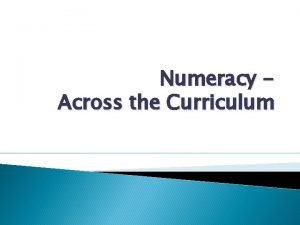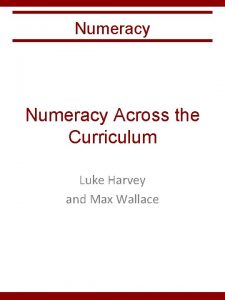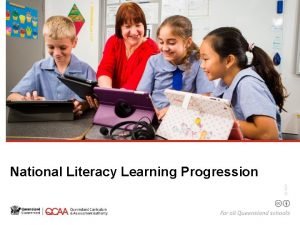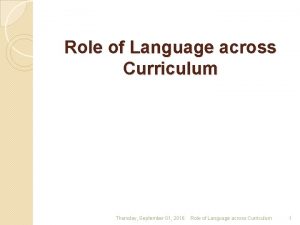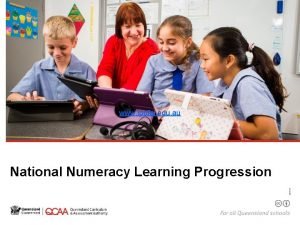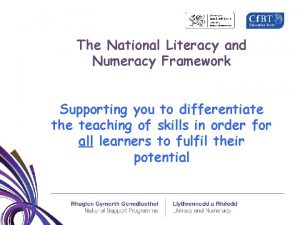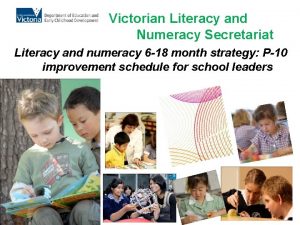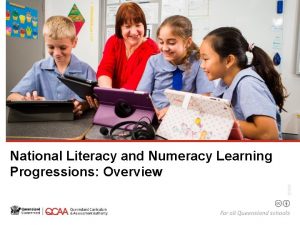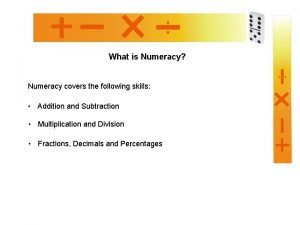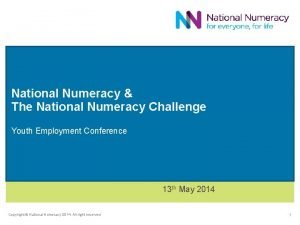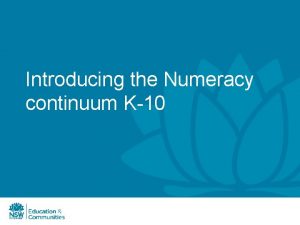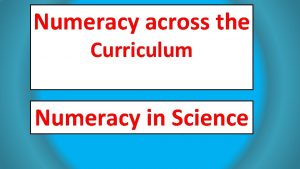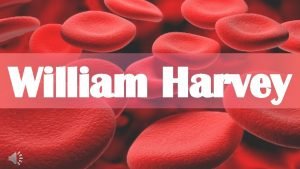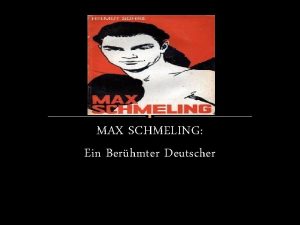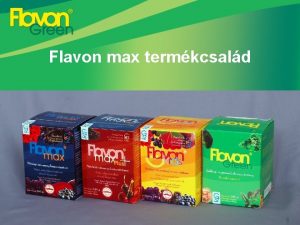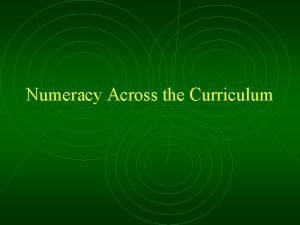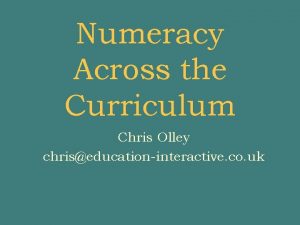Numeracy Across the Curriculum Luke Harvey and Max












- Slides: 12

Numeracy Across the Curriculum Luke Harvey and Max Wallace

Numeracy is the ability to reason and to apply simple numerical concepts (IT IS NOT JUST MATHS!) Soduku Mathematical Content (MATHS TEACHER) Mathematical Reasoning (EVERY TEACHER) Horizontal The numbers 1 -9 Vertical Logical deductions If it’s here then it can’t be there

Numeracy National Curriculum ‘Teachers should use every relevant subject to develop pupils’ mathematical fluency. ’ ‘Teachers should develop pupils’ numeracy and mathematical reasoning in all subjects so that they understand appreciate the importance of mathematics. ’

Numeracy We asked the teachers to go through their subjects and identify the numeracy in their courses. This is what they found…

Numeracy in MFL ¿Tienes hermanos? Surveys Count, tell the time and use foreign currency Ellie est plus grande que Sophie Identifying patterns in verbs Comparing

Underpinning observational drawing to allow artists to draw accurately from life. Grids and ratios are used to create and control scale and proportion of images. Visual elements come together through spatial awareness to create balance in work. Balance Proportion Shape, geometric and irregular, forms a large compositional tools for artists working in all materials and processes. Grid Ratio Numeracy in Art

Numeracy in Science Units Prefixes Length; metre (m) Time; second (s) Giga; G, 109 Centi; c, 10 -2 Mass; kilogram (kg) Mega; M, 106 Milli; m, 10 -3 Force; Newton (N) Kilo; k, 103 Micro; µ, 10 -6 Energy; Joule (J) Nano; n, 10 -9 Temperature; kelvin (K) Current; Ampere (A) Amount of substance; mole (mol) Balancing equations = is a balance = = =

Numeracy in Geography Grid References Scale Use the number across the bottom of the map first (Easting) then the number up the side of the map (Northing). The scale of a map is the ratio between the size of an object on the map and its real size. Representing Data You might represent data in a bar chart, a pie chart or a line graph. Climate graph Bar chart Line graph Pie chart

Numeracy in English Sequencing is frequently used to order the events in a play or novel For example, unmuddle these events from Macbeth into the correct order to show your understanding of the plot: Charting Character Development We use line graphs to chart how a character is developed. . . for example how tension in Macbeth increases with every new event Comparing two pieces of writing We use Venn diagrams to compare similarities/differences between two texts. . . for example how conflict is portrayed in Bayonet Charge and Exposure.

Numeracy in PE We use formulae to work out speeds achieved in races such as Usain Bolt’s 100 m and 200 m records? Measuring and timings are a key part of PE, we can use these to determine winners or progress in particular events. Problem solving is a key aspect of PE. Working out how to create fixtures (and how many) for tournaments is a maths problem!

Numeracy in History We use statistics to showcase the impact an event in History has had on the people living at that time. Statistics Timelines can be used to organise periods into their chronology. We can then identify causes and consequences of major events. Timelines

Exposure Proportional relationships between aperture, shutter speed and ISO are used to calculate exposure Visual problem solving is used continually when using balance to compose photographs effectively. Balance Symmetric compositions can be created in camera or in post-processing Symmetry Photographers make reference to a range of geometric shapes when using interesting and unusual compositions Shape Numeracy in Photography
 Numeracy across the curriculum audit
Numeracy across the curriculum audit Developing efficient numeracy strategies
Developing efficient numeracy strategies Australian curriculum numeracy progressions
Australian curriculum numeracy progressions Absolute min and max
Absolute min and max Conclusion for language across curriculum
Conclusion for language across curriculum Numeracy continuum qld
Numeracy continuum qld Literacy numeracy framework
Literacy numeracy framework Literacy and numeracy secretariat
Literacy and numeracy secretariat Scottish survey of literacy and numeracy
Scottish survey of literacy and numeracy Literacy and numeracy progressions
Literacy and numeracy progressions Numeracy stages
Numeracy stages National numeracy challenge
National numeracy challenge Numeracy learning continuum
Numeracy learning continuum
